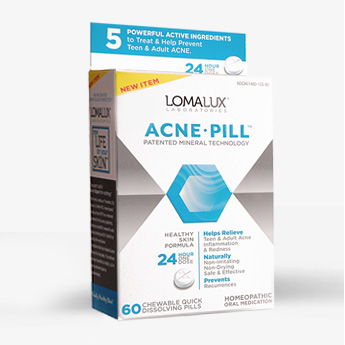They Don’t Call It Acne Vulgaris For Nothing.
Acne is the most common skin disorder that affects over 50 Million people in the US Alone
There are 4 types of acne: mild, moderate, severe and cystic. The most common acne is called Acne Vulgaris.
Doctors categorize acne into 4 grades: grade 1, grade 2, grade 3 & grade 4. Acne can also be classified by type of acne lesion: comedonal (non-inflammatory acne) and inflammatory acne lesions of pustules and cysts.
Your skin pores contain a gland (sebaceous gland) that produces sebum (oily substance). Sebum normally flows out onto the skin to act as a natural skin moisturizer. The glands are connected to hair follicles that allow the sebum to empty onto your skin.
Acne occurs when your glands produce too much sebum and it blocks your pores.
Adult Acne
There are two types of adult acne, persistent acne and late-onset acne. If teen acne has not cleared into adulthood, dermatologists call it persistent acne. Persistent acne can linger up to the 50+ age group.
Women are more susceptible to late-onset acne. Women who’ve never had acne or haven’t had acne for years can develop acne from triggers such as fluctuating hormones or from birth control pills.
Teen Acne
Nearly 85 – 90% of all people develop acne at some point between the ages 12 – 25.
Males often experience more severe acne symptoms than females.
Mild Acne
Grade 1 Acne
This type of acne often occurs in early adolescence – and can progress into more severe types of acne if not treated. Adults are also prone to mild acne. The forehead, nose and chin region are the most affected.
Mild Acne is categorized by having fewer than 20 whiteheads or blackheads, fewer than 15 inflamed bumps, or no more than a total of 30 lesions.
Moderate Acne
Grade 2 Acne
Moderate acne exhibits the same characteristics as mild acne, but now there is more skin inflammation – usually red acne spots that can be filled with pus. Breakout activity is more apparent.
This type of acne can progress to severe acne, particularly if the acne spots/pimples are picked frequently.
Moderate acne is classified as having 30 – 125 total lesions.
Severe Acne
Grade 3 Acne
In this type of acne, inflammation is more severe than moderate acne and acne now has spread to other areas of the body in addition to the face. Scarring risk is greater, as the inflammation has spread and affects deeper skin layers.
Severe acne should be treated by a doctor, as only prescription therapies will help relieve symptoms and prevent acne progressing to Grade 4/Cystic Acne. Speak to your doctor about prescribing Acunol®, an all-natural Rx oral medication that like Loma Lux AcnePill® works from the inside out to relieve acne.
Cystic Acne
Grade 4 Acne
Fortunately, this type of acne is rare, but is very painful and must be treated by a doctor, who can help minimize acne scarring and relieve the painful symptoms. Large pus-filled cysts are evident, along with extreme inflammation and acne breakouts on the face and other parts of the body.
As with severe acne, talk to your doctor about prescribing Acunol®, an all-natural Rx oral medication that can be used in combination therapy.

